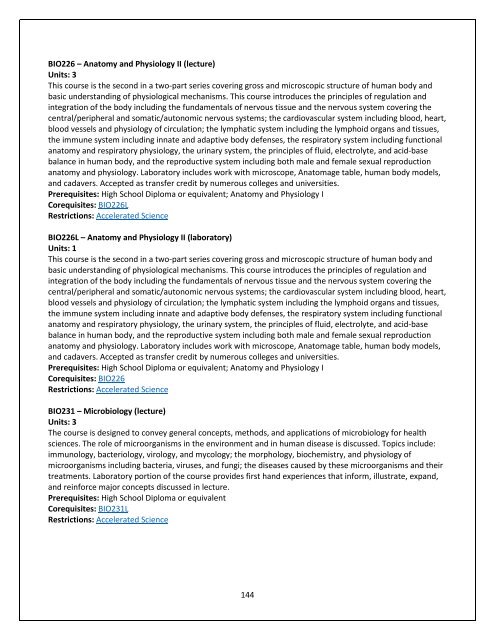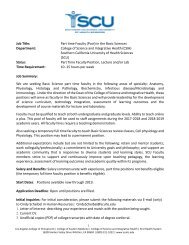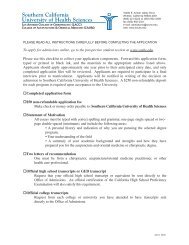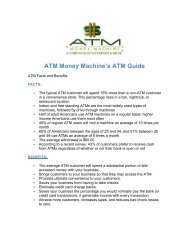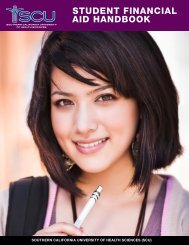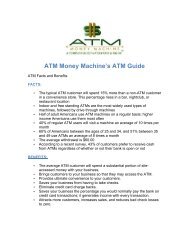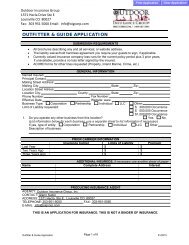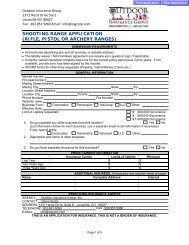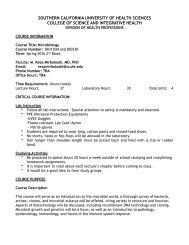Vision, Mission, and Guiding Principles for SCUHS
Southern California University of Health Sciences will be recognized as the premier evidence-based integrative healthcare university. in this PDF we are discussing about our Vision, Mission, and Guiding Principles. Please have a look. you can also go with this link: https://bit.ly/2JuIItL
Southern California University of Health Sciences will be recognized as the premier evidence-based integrative healthcare university. in this PDF we are discussing about our Vision, Mission, and Guiding Principles. Please have a look. you can also go with this link: https://bit.ly/2JuIItL
You also want an ePaper? Increase the reach of your titles
YUMPU automatically turns print PDFs into web optimized ePapers that Google loves.
BIO226 – Anatomy <strong>and</strong> Physiology II (lecture)<br />
Units: 3<br />
This course is the second in a two-part series covering gross <strong>and</strong> microscopic structure of human body <strong>and</strong><br />
basic underst<strong>and</strong>ing of physiological mechanisms. This course introduces the principles of regulation <strong>and</strong><br />
integration of the body including the fundamentals of nervous tissue <strong>and</strong> the nervous system covering the<br />
central/peripheral <strong>and</strong> somatic/autonomic nervous systems; the cardiovascular system including blood, heart,<br />
blood vessels <strong>and</strong> physiology of circulation; the lymphatic system including the lymphoid organs <strong>and</strong> tissues,<br />
the immune system including innate <strong>and</strong> adaptive body defenses, the respiratory system including functional<br />
anatomy <strong>and</strong> respiratory physiology, the urinary system, the principles of fluid, electrolyte, <strong>and</strong> acid-base<br />
balance in human body, <strong>and</strong> the reproductive system including both male <strong>and</strong> female sexual reproduction<br />
anatomy <strong>and</strong> physiology. Laboratory includes work with microscope, Anatomage table, human body models,<br />
<strong>and</strong> cadavers. Accepted as transfer credit by numerous colleges <strong>and</strong> universities.<br />
Prerequisites: High School Diploma or equivalent; Anatomy <strong>and</strong> Physiology I<br />
Corequisites: BIO226L<br />
Restrictions: Accelerated Science<br />
BIO226L – Anatomy <strong>and</strong> Physiology II (laboratory)<br />
Units: 1<br />
This course is the second in a two-part series covering gross <strong>and</strong> microscopic structure of human body <strong>and</strong><br />
basic underst<strong>and</strong>ing of physiological mechanisms. This course introduces the principles of regulation <strong>and</strong><br />
integration of the body including the fundamentals of nervous tissue <strong>and</strong> the nervous system covering the<br />
central/peripheral <strong>and</strong> somatic/autonomic nervous systems; the cardiovascular system including blood, heart,<br />
blood vessels <strong>and</strong> physiology of circulation; the lymphatic system including the lymphoid organs <strong>and</strong> tissues,<br />
the immune system including innate <strong>and</strong> adaptive body defenses, the respiratory system including functional<br />
anatomy <strong>and</strong> respiratory physiology, the urinary system, the principles of fluid, electrolyte, <strong>and</strong> acid-base<br />
balance in human body, <strong>and</strong> the reproductive system including both male <strong>and</strong> female sexual reproduction<br />
anatomy <strong>and</strong> physiology. Laboratory includes work with microscope, Anatomage table, human body models,<br />
<strong>and</strong> cadavers. Accepted as transfer credit by numerous colleges <strong>and</strong> universities.<br />
Prerequisites: High School Diploma or equivalent; Anatomy <strong>and</strong> Physiology I<br />
Corequisites: BIO226<br />
Restrictions: Accelerated Science<br />
BIO231 – Microbiology (lecture)<br />
Units: 3<br />
The course is designed to convey general concepts, methods, <strong>and</strong> applications of microbiology <strong>for</strong> health<br />
sciences. The role of microorganisms in the environment <strong>and</strong> in human disease is discussed. Topics include:<br />
immunology, bacteriology, virology, <strong>and</strong> mycology; the morphology, biochemistry, <strong>and</strong> physiology of<br />
microorganisms including bacteria, viruses, <strong>and</strong> fungi; the diseases caused by these microorganisms <strong>and</strong> their<br />
treatments. Laboratory portion of the course provides first h<strong>and</strong> experiences that in<strong>for</strong>m, illustrate, exp<strong>and</strong>,<br />
<strong>and</strong> rein<strong>for</strong>ce major concepts discussed in lecture.<br />
Prerequisites: High School Diploma or equivalent<br />
Corequisites: BIO231L<br />
Restrictions: Accelerated Science<br />
144


